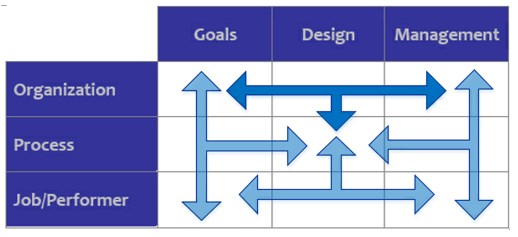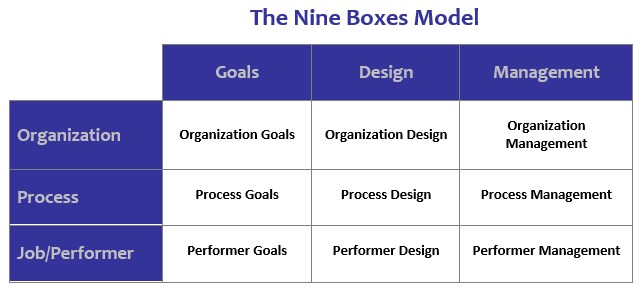Nine Performance Variables
In their book, Improving Performance: How to Manage the White Space on the Organization Chart, Geary Rummler and Alan Brache provide a guide for improving both individual and organizational performance. They developed a practical model for analyzing performance in order to prevent organizational problems while continuously improving performance.
Rummler & Brache Model
Rummler and Brache use a framework of nine performance variables that represent a comprehensive set of improvement levers that examine performance in an organizational system.
Their model is comprised of three levels of performance and three performance needs. The three levels of performance constitute one dimension of the framework, while the three performance needs comprise the second dimension.
Three Levels of Performance
- Organizational
- Process
- Job/performer
Three Performance Needs
- Goals
- Design
- Management

Rummler and Brache cross-match the three levels of performance with the three performance needs to create the nine performance variables.
Interconnected Variables
Rummler and Brache believe failure to manage these nine variables will lead to performance problems all throughout the organization. All nine variable are connected and intertwined, thus changing one will affect the other variables. Therefore, every performance improvement effort must be viewed as a whole through this matrix.

The Three Levels of Performance
Organizational Level – clear strategic goals, design/structure, and deployment of resources
Process Level – goals equal to the policies of the organization, process improvement methods, and reengineering interventions
Job/Performer Level – Individual goals and objectives, standards, performance management, coaching, and training interventions
These three levels are intricately depended on each other. Any change in strategy will result in change in process, which in turn will change the job responsibilities at the job level.
In order for the organization to be successful, the three levels should work together so that performance at the job level would contribute to the outcome of the process level, and as a result contribute to the organizational goals. Failure to successfully link the person, process, and organization will result in poor performance.
Improvement efforts must address all three levels at the same time. For example, if the process level changes, there may be new skills required at the job/performer level in order to complete the new tasks.
Performance Needs
Goals – Having clear goals at each level ensures alignment to desired results of the organization
Design – Having an effective design at each level maximizes the efficiency of operation as a whole and enables goals to be met
Management – Having good management systems and practices at each level ensures that the organization can meet their goals and adapt to challenges in the business environment.
It is important for the organization to set their goals so that the job/performer has goals that are linked to the organizations’. This way the organization’s goals and individual goals are in sync, and everyone in the organizations is efficiently moving in the same direction with little conflict.
It is also very important to have an effective design at each level. An effective design is one that is robust, scalable, and reliable. This type of design is able to operate efficiently under various conditions and can withstand the pressures of a constantly changing business environment.
Lastly, having good management at all the levels ensures that the organization is able to thrive and withstand challenging situations in business environment.

The Nine Boxes Model
ORGANIZATION LEVEL
Organization Goals – Strategy, operating plans, and metrics
Organization Design – Organization structure and business model
Organization Management – Performance review practices and management culture
PROCESS LEVEL
Process Goals – Customer and business requirements
Process Design – Process design, systems design, and workspace design
Process Management – Process ownership, process management, and continuous improvement
JOB/PERFORMER LEVEL
Performer Goals – Job specifications, performance metrics, and individual development plans
Performer Design – Job roles and responsibilities, skill requirements, procedures, tools, and training
Performer Management – Performance feedback, consequences, coaching, and support
References
Improving Performance: How to Manage the White Space on the Organization Chart, Geary Rummler and Alan Brache.
